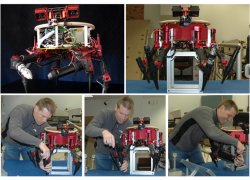
(Red Orbit) "Lemur," short for the Limbed Excursion Mechanical Utility Robot, was originally conceived to help maintain future spacecraft and space stations. It weighs in at just 26 pounds (12 kilograms) and is small enough to hitch a ride on the space shuttle or NASA's planned crew exploration vehicle.
"Lemur could be an astronaut's pet monkey," says JPL engineer Brett Kennedy, principal investigator for the robotic project. "It can perform tasks that are too small for astronauts to do easily. It's built to get into the nooks and crannies of a structure."
This robot is equipped with a swivel camera, enabling to simply "turn its head" instead of having to move the entire body around. It also comes with a microscope camera about the size of a palm, enabling it to examine items up close. If approved for space, this robot may be a handy item, not only for the space station, but perhaps also for the Moon and Mars.

(Red Orbit) To make Lemur flexible and versatile, Kennedy and his team combined the body styles and abilities of an octopus, a crab and a primate into a six-limbed robot with Swiss army knife tendencies. Attachable tools fit onto each limb and perform a variety of functions. Lemur can support itself evenly on three legs while two other limbs are freed up to work. And the sixth limb? "It's a bonus, and besides, five limbs would look funny," Kennedy says. [...]
With all its gadgetry and talents, Lemur might have a bright future not only as an assistant astronaut, but also as a Martian rock climber. Lemur could scamper up much steeper hills and cliffs than the Spirit and Opportunity rovers that are currently wheeling around on Mars. "We built Lemur with limbs so it can use both arms and legs just as a biological primate would," Kennedy said.
Inspired by nature, this "creature" would be very beneficial towards future colonists everywhere. Hopefully this device will not be too expensive for NASA to launch, as they already have a tight budget to work with.
Want more space geek news? Then subscribe below via email, RSS or twitter for free updates! Prefer another service? How about via RSS or follow Colony Worlds on Twitter!




![ColonyWorlds[at]Gmail[dot]com](http://img.photobucket.com/albums/v438/hiddennook/ColonyWorlds.png)







No comments:
Post a Comment
You can either visit the stars or watch them from afar.
But if you choose the former, you'll definitely get a better view.
~Darnell Clayton, 2007
Note: You do not need a Blogger account in order to comment, but you do need to solve the universal puzzle below.